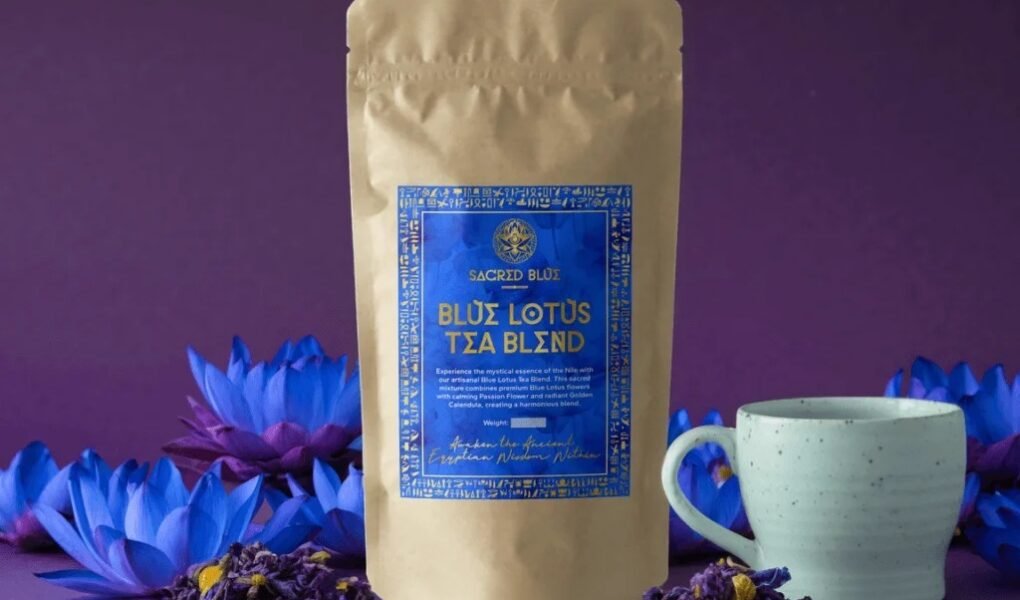Blue lotus tea has captivated the hearts of tea lovers and spiritual seekers alike for centuries. Known for its mesmerizing blue petals and gentle psychoactive properties, this ancient herbal infusion has a deep-rooted connection with Egyptian rituals, spiritual awakening, and relaxation. The Blue Lotus (Nymphaea caerulea) is more than just a visually stunning flower—it is a symbol of rebirth, tranquility, and divine connection.
In this article, we will take a deep dive into the history, preparation, benefits, and modern uses of Blue Lotus Tea, exploring its unique qualities and the science behind its revered effects.
The Origins and History of Blue Lotus
Ancient Egyptian Significance
The Blue Lotus, also known as the Egyptian Blue Water Lily, played an integral role in ancient Egyptian culture. Archaeological evidence suggests that it was not only a symbol of the sun and rebirth but also a sacred plant used in spiritual ceremonies. Ancient Egyptian art frequently depicts gods and pharaohs holding or surrounded by the Blue Lotus, emphasizing its divine importance.
The flower was associated with the gods Ra (the sun god) and Nefertem (the god of perfume and healing). Egyptians believed that the Blue Lotus opened with the sunrise and closed at sunset, symbolizing the cyclical nature of life and the journey of the soul. It was often infused into wines and oils to create a mildly euphoric effect that enhanced meditation, social gatherings, and spiritual experiences.
Global Spread and Historical Use
After its prominence in Egypt, the Blue Lotus traveled through trade routes to other ancient civilizations, including Greece and India. The Greeks regarded it as a symbol of purity and serenity, while in Ayurvedic practices, the plant was valued for its calming and aphrodisiac qualities.
Today, Blue Lotus Tea continues to enchant tea enthusiasts worldwide, blending ancient tradition with modern wellness practices.
What Is Blue Lotus Tea?
Botanical Background
Blue Lotus Tea is made by steeping the dried petals or buds of the Nymphaea caerulea plant in hot water. This aquatic plant thrives in the still waters of the Nile and other parts of East Africa. The tea is naturally caffeine-free, offering a gentle, relaxing experience without the jitteriness often associated with caffeinated beverages.
When brewed, the tea exhibits a soft floral aroma with earthy undertones and a subtly sweet taste. Some describe it as having a faintly fruity and anise-like flavor that lingers on the palate.
Chemical Composition and Active Compounds
The relaxing and mildly psychoactive effects of Blue Lotus Tea come from two primary alkaloids:
- Nuciferine – Known for its calming and mood-enhancing properties. It is a natural dopamine receptor modulator that promotes relaxation without sedation.
- Aporphine – A natural compound that induces mild euphoria and relaxation. It helps reduce anxiety and promotes a feeling of contentment.
These compounds work synergistically to provide a serene yet alert mental state, making Blue Lotus Tea a popular choice for meditation, stress relief, and emotional balance.
How to Prepare Blue Lotus Tea
Traditional Brewing Method
To fully appreciate the delicate flavors and benefits of Blue Lotus Tea, it is important to brew it correctly.
Ingredients:
- 1 to 2 teaspoons of dried Blue Lotus petals or a whole flower
- 1 cup of hot water (around 85–90°C)
- Optional: honey or lemon for added flavor
Preparation Steps:
- Heat the water but do not boil it completely, as boiling may destroy some beneficial compounds.
- Place the dried petals in a teapot or infuser.
- Pour the hot water over the petals.
- Allow it to steep for 5 to 10 minutes, depending on desired strength.
- Strain and enjoy the tea warm.
For a stronger brew, some prefer to steep the tea for up to 15 minutes or to add a few drops of Egyptian Blue Lotus Extract to enhance potency and flavor.
Other Preparation Styles
Apart from traditional brewing, Blue Lotus can also be infused into wine, mixed with other herbal teas, or incorporated into tinctures and aromatherapy blends. Each preparation method provides a slightly different experience, from subtle relaxation to deeper meditative effects.
Health Benefits of Blue Lotus Tea
1. Promotes Relaxation and Reduces Stress
The soothing properties of Blue Lotus Tea make it a natural stress reliever. The alkaloids in the tea interact with serotonin and dopamine receptors, promoting feelings of peace and happiness. It is often consumed before meditation, yoga, or bedtime to calm the mind and body.
2. Enhances Sleep Quality
Because of its mild sedative effects, Blue Lotus Tea can help improve sleep quality. Drinking a cup before bed helps the mind unwind and encourages deeper, more restorative sleep.
3. Supports Emotional Well-being
Regular consumption may assist in emotional regulation and the reduction of anxiety symptoms. Many people report a gentle mood lift and a sense of inner balance after drinking the tea.
4. Aphrodisiac and Libido Enhancer
Historically, the Blue Lotus was prized for its aphrodisiac qualities. It was used by ancient Egyptians to enhance intimacy and passion. Modern research suggests that Egyptian Blue Lotus Extract contains compounds that may increase blood circulation and stimulate desire naturally.
5. Antioxidant and Anti-inflammatory Properties
The Blue Lotus is rich in antioxidants that combat oxidative stress and inflammation. These antioxidants help neutralize free radicals, protecting cells and tissues from damage.
Egyptian Blue Lotus Extract: A Concentrated Form
Egyptian Blue Lotus Extract is a more potent derivative of the flower, often used for aromatherapy, tinctures, and enhanced tea blends. The extract retains all the natural alkaloids and essential oils of the flower but in a concentrated form.
It can be used in small doses to elevate the calming effects of Blue Lotus Tea or added to skincare formulations for its antioxidant benefits. Due to its purity and potency, only a few drops are needed to experience its tranquil influence.
Modern Applications and Cultural Revival
In today’s wellness culture, Blue Lotus Tea is enjoying a resurgence as people seek natural ways to manage stress and reconnect with inner peace. It has found a place in holistic healing practices, herbal therapy, and even artistic rituals such as tea ceremonies and sound healing sessions.
Some spiritual practitioners use the tea as an aid for lucid dreaming and deep meditation, while others simply enjoy its serene effects as part of their evening relaxation routine.
Safety, Precautions, and Legal Status
Blue Lotus Tea is generally considered safe when consumed in moderate amounts. However, it may cause mild drowsiness in some individuals. It is not recommended for pregnant or breastfeeding women, and those taking antidepressants or sedatives should consult a healthcare professional before use.
In most countries, including the United States, the Blue Lotus flower and extract are legal for sale and consumption. However, it is not approved for human consumption in some regions as a dietary supplement, so it’s important to check local regulations.
Conclusion
The allure of Blue Lotus Tea lies not only in its captivating color and delicate flavor but also in its deep historical and spiritual roots. From the temples of ancient Egypt to modern-day wellness rituals, this sacred flower continues to offer serenity, balance, and connection to the divine.
Whether enjoyed as a soothing beverage, used in aromatherapy, or enhanced with Egyptian Blue Lotus Extract, this ancient elixir reminds us that true tranquility comes from nature’s most beautiful creations.
Blue Lotus Tea remains a timeless testament to humanity’s enduring quest for harmony between body, mind, and spirit.




